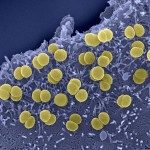Link to Pubmed [PMID] – 20168263
Pediatr. Infect. Dis. J. 2010 Jul;29(7):618-23
BACKGROUND: Neisseria meningitidis meningitis represents approximately one-half of the meningococcal cases in French children. To explore the contribution of bacterial typing in improving the management of cases, we aimed to describe clinical characteristics and mortality of meningococcal meningitis in children reported to the multicenter survey system, GPIP/ACTIV, in association with phenotypes/genotypes of bacterial isolates.
METHODS: From 2001 to 2005, 259 pediatric wards and 168 microbiology laboratories enrolled all children with bacterial meningitis. Risk factors, vaccination status, signs and symptoms, cerebrospinal fluid analysis, treatments and case fatality rate were recorded.
RESULTS: A total of 962 cases of Neisseria meningitidis meningitis among a total of 2131 bacterial meningitis (45%) were recorded (mean age, 4.5 +/- 4.7 years). Serogroup distribution of the isolates was 62.3%, 33.7%, 2.9%, 0.6%, and 0.6% for serogroups B, C, W135, A and Y, respectively. The major clonal complexes were ST-41/44 (32.2%), ST-11 (21.9%), ST-32 (20.8%), ST-8 (8.2%), and ST-269 (4.9%). Despite global heterogeneity of the isolates, 2 phenotypes/genotypes were of interest. Isolates of the phenotype/genotype B:14:P1.7,16/ST-32 (56% clustered in the region of Haute Normandie) were observed in older children (8.6 years) and were associated with a higher case fatality rate (12%) than were other phenotypes of serogroup B. The phenotype/genotype C:2a:P1.5/ST-11 was found in 26.3% of serogroup C cases and was possibly associated with a higher mortality among serogroup C (9.9% for C and 5.9% for B, P = 0.04).
CONCLUSIONS: This large survey provides data that could be important for implementation of future vaccines. Typing of meningococcal isolates could contribute to an understanding of prognosis in meningococcal meningitis.

